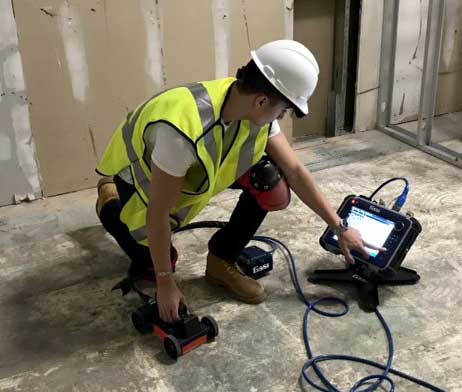RainierGPR Service Areas: Trusted Concrete Scanning Services in Numerous Areas
RainierGPR Service Areas: Trusted Concrete Scanning Services in Numerous Areas
Blog Article
Concrete Scanning: An Essential Action In The Direction Of Ensuring Architectural Stability and Safety
In the realm of building and framework maintenance, the relevance of concrete scanning can not be overemphasized. This thorough procedure holds the essential to unveiling potential dangers hidden underneath the surface area of seemingly solid frameworks. By using innovative technology and techniques, concrete scanning acts as a pivotal device in ensuring that the integrity and safety and security of bridges and structures are maintained to the highest standards. However, beyond its surface-level ramifications, the function of concrete scanning expands much deeper than satisfies the eye.
Significance of Concrete Scanning
Concrete scanning plays an important duty in making sure the architectural stability and security of buildings and facilities projects. By using innovative technologies such as ground-penetrating radar (GPR) and electro-magnetic induction, experts can non-destructively check concrete structures to detect potential problems, gaps, embedded things, and reinforcement format. This procedure enables very early detection of abnormalities that can jeopardize the security of a structure, preventing pricey problems and ensuring the safety of occupants.
Prior to exploration, reducing, or coring into concrete, scanning assists determine the specific locations of rebar, post-tension wires, and other embedded elements, minimizing the risk of unintended hits that can lead to architectural weak points. Additionally, concrete scanning aids in quality control by verifying the thickness of concrete covers and identifying any discrepancies that might influence the general sturdiness of the structure.
Technology for Concrete Assessment

Benefits of Very Early Discovery
Timely detection of architectural concerns can considerably alleviate dangers and ensure the durability of construction projects. By determining possible problems beforehand in the building process, stakeholders can take proactive steps to attend to issues before they escalate into larger and much more costly issues. One of the crucial advantages of very early discovery is the avoidance of architectural failings, which can posture significant safety dangers and lead to task delays and monetary losses.
Additionally, very early detection permits timely repair work and maintenance, which can assist expand the life-span of the structure. By dealing with problems immediately, construction groups can avoid costly repair services or even the demand for early replacement of structural parts. This positive approach not only conserves money and time however additionally improves the general safety and security and durability of the construction project.
Additionally, very early detection can enhance job preparation and decision-making by offering stakeholders with beneficial insights right into the condition of the structure. Equipped with this information, task supervisors can make educated options pertaining to construction timelines, methods, and products, leading to much more effective and successful task outcomes.
Making Sure Architectural Security
Ensuring the structural security of a construction project is paramount to its safety and security and long life. Architectural security refers to the ability of a structure or facilities to keep its form and function under ecological conditions and different lots. To achieve this, thorough evaluation and tracking of the framework are crucial. Concrete scanning plays a critical function in guaranteeing structural security by detecting potential problems such as spaces, delamination, or support corrosion that could compromise the integrity of the structure in time.
By using sophisticated scanning technologies like ground-penetrating radar (GPR) and electromagnetic induction, building and construction specialists can non-invasively evaluate concrete structures to identify areas of concern below the surface area. This positive method allows for the early detection of flaws or weaknesses, making it possible for timely fixings or reinforcement to avoid architectural failures.
Regular concrete scanning during Read Full Article different construction phases and throughout the life cycle of a structure can assist preserve its security, mitigate threats, and guarantee the security of passengers. By focusing on architectural security through concrete scanning, construction tasks can enhance their strength and resilience, ultimately adding to greater safety and durability.

Avoiding Important Failings
To safeguard versus catastrophic events, thorough monitoring and aggressive maintenance are important in preventing vital failings within architectural frameworks. Spotting possible issues before they intensify is essential to stop structural failures. Implementing regular examinations, such as concrete scanning, can disclose covert problems like voids, cracks, or corrosion that might endanger the stability of a structure. By using advanced scanning innovations like Ground Permeating Radar (GPR) or Concrete X-ray, designers can non-destructively examine the condition of concrete and determine powerlessness that require reinforcement or repair work - RainierGPR Service Areas.

Conclusion
In final thought, concrete scanning plays a critical role in making certain architectural stability and security by using innovative innovation for very early discovery of potential concerns. This positive approach aids prevent important failings and ensures the security of structures. It is important to focus on concrete inspection as a common technique to protect the longevity and security of buildings and infrastructure.
Concrete scanning plays an essential function in making certain the structural honesty and safety of structures and infrastructure projects. In addition, concrete scanning aids in quality control by confirming the thickness of concrete covers and spotting any inconsistencies that might impact the total longevity of the structure. Concrete scanning plays an important function in making sure architectural useful content stability by discovering possible concerns such as gaps, delamination, or reinforcement corrosion that could jeopardize the stability of the framework over time.

In final thought, concrete scanning plays a vital duty in making certain architectural honesty and security by using innovative modern check that technology for early discovery of prospective concerns.
Report this page